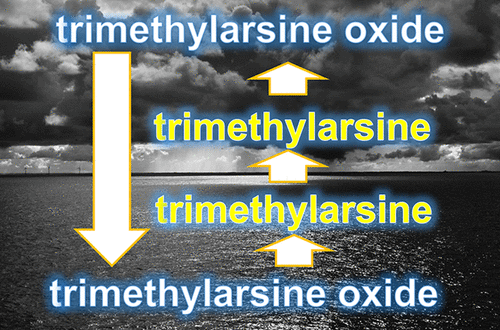当前位置:
X-MOL 学术
›
Environ. Sci. Technol.
›
论文详情
Our official English website, www.x-mol.net, welcomes your feedback! (Note: you will need to create a separate account there.)
Biovolatilization of Arsenic as Arsines from Seawater
Environmental Science & Technology ( IF 11.4 ) Pub Date : 2018-03-13 00:00:00 , DOI: 10.1021/acs.est.7b06456 Laurie Savage 1 , Manus Carey 1 , Paul N. Williams 1 , Andrew A. Meharg 1
Environmental Science & Technology ( IF 11.4 ) Pub Date : 2018-03-13 00:00:00 , DOI: 10.1021/acs.est.7b06456 Laurie Savage 1 , Manus Carey 1 , Paul N. Williams 1 , Andrew A. Meharg 1
Affiliation

|
Marine sources of arsenic to the atmosphere are normally dismissed as minor. Here we show that arsenic can be biovolatilized from seawater, and that biovolatilzation is based on organic arsenic species present in the seawater. Even though inorganic arsenic is in great excess in seawaters, it is trimethylarsine (TMA) that is the primary biovolatilized product, with dimethylarsine (DMA) also observed if dimethylarsinic acid (DMAA) is spiked into seawaters. With respect to budgets, 0.04% of the total arsenic in the seawater was biovolatilized over a 2-week incubation period. To test the environmental significance of this finding, wet deposition was analyzed for arsenic species at coastal locations, one of which was the origin of the seawater. It was found that the oxidized product of TMA, trimethylarsine oxide (TMAO), and to a less extent DMAA were widely present. When outputs for arsines (0.9 nmol/m2/d) from seawater and inputs from wet deposition (0.3–0.5 nmol/m2/d) were compared, they were of the same order of magnitude. These findings provide impetus to reexamining the global arsenic cycle, as there is now a need to determine the flux of arsines from the ocean to the atmosphere.
中文翻译:

海水中砷作为砷的生物挥发
海洋中向大气中砷的来源通常被认为是次要的。在这里,我们表明砷可以从海水中生物挥发,而生物挥发是基于海水中存在的有机砷物质。即使海水中的无机砷含量过高,但主要的生物挥发产物仍是三甲基ar(TMA),如果将二甲基in酸(DMAA)加标到海水中,也会观察到二甲基ar(DMA)。关于预算,在2周的潜伏期中,海水中总砷的0.04%被生物挥发。为了测试该发现对环境的重要性,对沿海地区的砷物种进行了湿沉降分析,其中之一是海水的来源。发现TMA的氧化产物三甲基ar氧化物(TMAO)DMAA的普及程度较低。当输出outputs(0.9 nmol / m比较了海水中的2 / d)和湿沉降的输入(0.3-0.5 nmol / m 2 / d),它们的数量级相同。这些发现为重新审视全球砷循环提供了动力,因为现在需要确定从海洋到大气的rs的通量。
更新日期:2018-03-14
中文翻译:

海水中砷作为砷的生物挥发
海洋中向大气中砷的来源通常被认为是次要的。在这里,我们表明砷可以从海水中生物挥发,而生物挥发是基于海水中存在的有机砷物质。即使海水中的无机砷含量过高,但主要的生物挥发产物仍是三甲基ar(TMA),如果将二甲基in酸(DMAA)加标到海水中,也会观察到二甲基ar(DMA)。关于预算,在2周的潜伏期中,海水中总砷的0.04%被生物挥发。为了测试该发现对环境的重要性,对沿海地区的砷物种进行了湿沉降分析,其中之一是海水的来源。发现TMA的氧化产物三甲基ar氧化物(TMAO)DMAA的普及程度较低。当输出outputs(0.9 nmol / m比较了海水中的2 / d)和湿沉降的输入(0.3-0.5 nmol / m 2 / d),它们的数量级相同。这些发现为重新审视全球砷循环提供了动力,因为现在需要确定从海洋到大气的rs的通量。


























 京公网安备 11010802027423号
京公网安备 11010802027423号